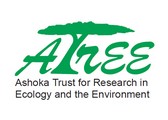Any and all opinions expressed in this newsletter are solely those of the author(s) and do not reflect the opinion of ATREE.
Centre for Excellence in Conservation Science
Royal Enclave,Srirampura,Jakkur Post
Bangalore-560064
Telephone: 080-23635555 (EPABX)
Fax : 080- 23530070
Presence of religious sites in biodiversity rich forest areas is a global phenomenon. India is no exception where many forests including Protected Areas have important religious sites with many being visited by large number of people. Common examples include Sabarimala Temple (Periyar Tiger Reserve), Kedarnath Temple (Kedarnath Wild Life Sanctuary) and Biligiri Rangaswamy Temple (BRT Tiger Reserve). Kalakad Mundanthurai Tiger Reserve (KMTR) encompasses various religious sites with varying degrees of importance and following. Largest among them is Sorimuthian kovil (SMK), built by Singampatti Palayam of the erstwhile Pandyan Dynasty. The temple premises, including the sanctum sanctorum is located in the Mundanthurai range. Popular estimates claim that about 5 lakh people visit this temple during the new moon day (amavasai) in Tamil month of Aadi (July-August) every year. Among the numerous impacts that such a large influx of people can have on natural forests, the most conspicuous is the left over waste littered indiscriminately on the forest floor and floating in the water bodies. The introduction of plastic as a cheap, convenient and disposable packaging material in our culture has spiraled this problem beyond control.
Till 2005 our efforts to counter the problem was very small scale and scattered. It was then that the KMTR forest managers approached us to forge an active partnership with them in-order to find effective means to ease the pressure exerted on forests due to the enormous congregation of pilgrims. Imminent problem at hand was to immediately take care of the colossal amount of waste that was being generated every year. Our action oriented campaign ranging from frisking the visitors (for polythene bags) to clearing left over garbage after the festival, proved quite successful in reducing entry and persistence of wastes inside the forests. Such an approach, which requires continuous efforts of high-scale without
bringing about any perceivable change in the attitude or behavior of the pilgrims, seemed neither sustainable nor offered any long-term solution. Thus the idea of a comprehensive campaign which would target not just the visitors but also the managers and policy makers started taking shape. It was soon formulated and came to include a strong monitoring component. Over the course of time, this late offshoot of our original campaign soon evolved into a crucial component backing our outreach and awareness with robust empirical evidences of the impacts wreaked by the festival. Initiated in 2008, we designed a traffic census survey and arrived at a reliable measure of the number of visitors to the festival. Simultaneously we also started estimating abundances of mammals and number of road-kills across the temple forest landscape to investigate the spatial extent of the festival's impact on terrestrial animals. A single point sample gave us a good idea about the potential impact of the festival. We now knew that about 1.5 -1.7 lakh visitors came to the festival over the three days and in the process was responsible for death of over 1700 animals which range from frogs, reptiles, insects and also displacing larger wild life from the area and denuding the forest understory apart from polluting the river. However new questions emerged: How are the animal communities responding to such
intense disturbance over larger temporal scales? Will these changes influence the ecosystem and the habitat functions? After three years of study, faint trends seem to be emerging. Preliminary analysis points
towards overall decline in abundances of the animals but requires rigorous statistical testing before we can say anything conclusive about population-level trends of the animal community. Road-kill estimates, which showed significant increases during the festival, also point towards an emerging pattern of local extinctions for many invertebrate species. during the festival. Traffic survey points towards an average annual increase of 11,000 visitors over the last three years. Last year we also started looking at changes that is being brought about in the vegetation structure and composition. The study points out that the canopy is gradually opening up due to repeated camping. With more temporal sampling we are trying to see if such destructive camping practices are
responsible for the transformation of the dry evergreen to thickets.
We designed a visitor's survey in 2008 to gain insights about their motivations, aspirations and incentives to visit the temple. We repeated the survey in 2010 to see if the last two years of campaign has had any impact in creating a forest friendly attitude among the visitors. The results were heartening as it did point towards a greater knowledge about impacts of plastic waste inside the forest and it also showed that people were willing to forego a few inconveniences if it meant better conservation of the forests. On sharing the results with the district administration and the forest department, we could facilitate two conservation-friendly interventions: complete ban on the use of disposable plastic items inside the forests and provisional regulation on night traffic during the festival. Among the important future tasks and plans, first and foremost is to disseminate the results and findings in outlets that would help create links and networks with stakeholders. By setting up socio ecological monitoring, we hope to continue to remind the stakeholders that they need to do more for the festival impacts to show a declining trend. Only then can we call it a 'green forest festival'.
&
nbsp;
Editorial Team
Editor: Allwin Jesudasan
Associate editor: Rajkamal Goswami
Editorial Review: R. Ganesan, M. Soubadra Devy, T. Ganesh
Design and presentation: Kiran Salegame
A S H O K A T R U S T F O R R E S E A R C H I N E C O L O G Y A N D T H E E
N V I R O N M E N T
Monitoring for a ‘greener’ forest festival
-Rajkamal Goswami
If you have any suggestions or comments please let us know through the boxes below






